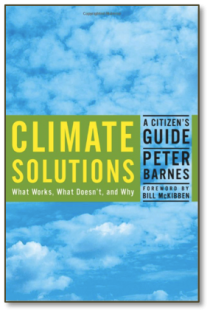Climate Solutions

From the Introduction
IN 2006, NASA’s top climate scientist warned that we have at most a decade to turn the tide on global warming. After that, James Hansen said, all bets are off. Temperature rises of 3 to 7 degrees Farenheit will “produce a different planet.”
If Hansen is right—and most scientists think he is—then every year lost is a year closer to the precipice. In more positive terms, we have one last chance—but only one—to save the planet.
This guide is about that last chance. Its two premises are: (1) the climate crisis must be solved now, and (2) popular understanding is a pre-requisite to getting a solution that actually solves the problem.
What’s the problem? For many decades, human emissions of greenhouse gases have exceeded the atmosphere’s capacity to absorb them. We need an economy-wide system to reduce those emissions steadily and surely. If a policy doesn’t create such a system, it may be helpful, but it won’t be enough.
THE ATMOSPHERE itself is a commons—a gift of creation to all. It performs many vital planetary functions, including climate maintenance. The trouble is, we humans—and especially we Americans—are disturbing it with our pollution. Even though we know we’re doing this, we don’t stop. Indeed, we can’t stop as long as our current system for using the atmosphere persists.
That system—first come, first served, no limits and no prices—is clearly dysfunctional. One alternative is rationing—limiting total use and giving everyone equal or differential usage rights. Rationing worked during two World Wars, but we’re loath to use it again—we prefer market mechanisms to government chits. Such a preference is fine, but it doesn’t change the fact that we need an economy-wide system to reduce atmospheric disturbance. The design of that system is what the debate is about.
Here are a few principles that can help us think about that design:
. The simpler a system is, the more likely it is to work.
. The fairer a system is, the more likely it is to last.
. In the future, polluters should pay for the right to pollute.
The third principle is particularly important because, when all is said and done, the debate about system design is a debate about who will pay whom. Many large and powerful companies are happy with the arrangement in which polluters pay nothing. But pollution has real costs, and if we want to fix the climate crisis, someone must pay them. If polluters don’t, others will.
 Free distribution with attribution
Free distribution with attribution